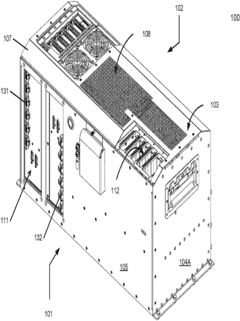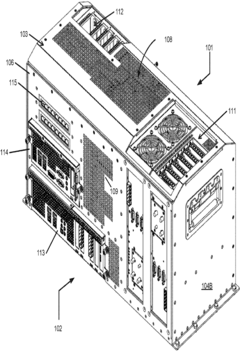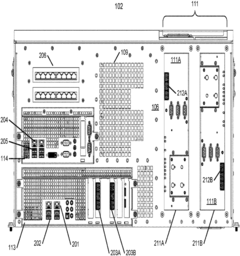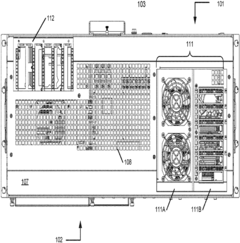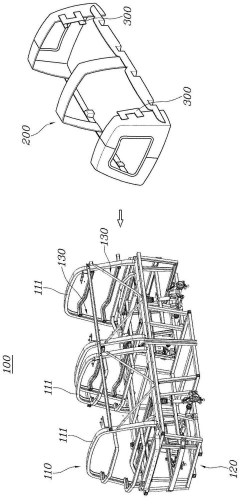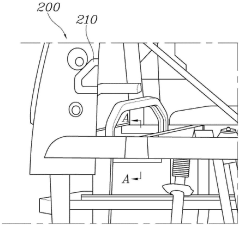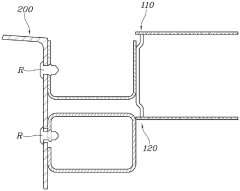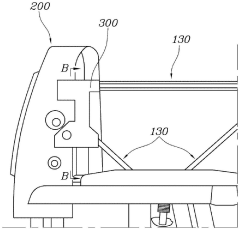How to Integrate K24 Engine Into Custom Vehicle Builds?
JUL 3, 20259 MIN READ
Generate Your Research Report Instantly with AI Agent
Patsnap Eureka helps you evaluate technical feasibility & market potential.
K24 Engine Integration Background and Objectives
The K24 engine, developed by Honda, has become a popular choice for custom vehicle builds due to its reliability, performance potential, and widespread availability. This report aims to explore the integration of the K24 engine into custom vehicle projects, examining the technical background, evolution, and objectives of such endeavors.
The K24 engine series was first introduced in 2001 as part of Honda's K-series engine family. Initially designed for use in various Honda and Acura models, the K24 quickly gained recognition for its robust design and tuning potential. Over the years, the engine has undergone several iterations, with improvements in power output, efficiency, and emissions control.
Custom vehicle builders have increasingly turned to the K24 engine as a versatile powerplant for a wide range of projects. The engine's popularity stems from its ability to produce significant power in stock form, coupled with its responsiveness to aftermarket modifications. This combination makes it an attractive option for enthusiasts seeking to enhance the performance of their vehicles or create unique builds.
The integration of a K24 engine into a custom vehicle build presents both opportunities and challenges. Objectives for such projects often include increasing horsepower and torque, improving fuel efficiency, and achieving a harmonious blend of modern engine technology with classic or custom vehicle designs. Additionally, builders aim to overcome fitment issues, address electrical integration, and ensure proper cooling and exhaust systems are in place.
As the automotive landscape evolves, the goals of K24 engine integration have expanded to include compatibility with hybrid systems, adaptation to alternative fuels, and meeting increasingly stringent emissions standards. This has led to a growing interest in electronic engine management systems and advanced tuning techniques to maximize the engine's potential while adhering to regulatory requirements.
The technical evolution of K24 engine integration has seen advancements in areas such as engine mounts, wiring harness adaptations, and custom fabrication techniques. These developments have made it easier for builders to incorporate the K24 into a diverse range of vehicle platforms, from classic muscle cars to modern sports cars and even off-road vehicles.
Understanding the background and objectives of K24 engine integration is crucial for successful custom builds. It requires a comprehensive knowledge of the engine's specifications, its potential for modification, and the specific challenges associated with integrating it into different vehicle types. By setting clear goals and understanding the technical landscape, builders can create innovative and high-performance vehicles that showcase the K24's capabilities.
The K24 engine series was first introduced in 2001 as part of Honda's K-series engine family. Initially designed for use in various Honda and Acura models, the K24 quickly gained recognition for its robust design and tuning potential. Over the years, the engine has undergone several iterations, with improvements in power output, efficiency, and emissions control.
Custom vehicle builders have increasingly turned to the K24 engine as a versatile powerplant for a wide range of projects. The engine's popularity stems from its ability to produce significant power in stock form, coupled with its responsiveness to aftermarket modifications. This combination makes it an attractive option for enthusiasts seeking to enhance the performance of their vehicles or create unique builds.
The integration of a K24 engine into a custom vehicle build presents both opportunities and challenges. Objectives for such projects often include increasing horsepower and torque, improving fuel efficiency, and achieving a harmonious blend of modern engine technology with classic or custom vehicle designs. Additionally, builders aim to overcome fitment issues, address electrical integration, and ensure proper cooling and exhaust systems are in place.
As the automotive landscape evolves, the goals of K24 engine integration have expanded to include compatibility with hybrid systems, adaptation to alternative fuels, and meeting increasingly stringent emissions standards. This has led to a growing interest in electronic engine management systems and advanced tuning techniques to maximize the engine's potential while adhering to regulatory requirements.
The technical evolution of K24 engine integration has seen advancements in areas such as engine mounts, wiring harness adaptations, and custom fabrication techniques. These developments have made it easier for builders to incorporate the K24 into a diverse range of vehicle platforms, from classic muscle cars to modern sports cars and even off-road vehicles.
Understanding the background and objectives of K24 engine integration is crucial for successful custom builds. It requires a comprehensive knowledge of the engine's specifications, its potential for modification, and the specific challenges associated with integrating it into different vehicle types. By setting clear goals and understanding the technical landscape, builders can create innovative and high-performance vehicles that showcase the K24's capabilities.
Market Analysis for K24 Engine Swaps
The market for K24 engine swaps has experienced significant growth in recent years, driven by the engine's reputation for reliability, performance, and versatility. This Honda-produced inline-four engine has become a popular choice for custom vehicle builds across various platforms, extending beyond its original applications in Honda and Acura models.
The demand for K24 engine swaps is primarily fueled by automotive enthusiasts seeking to upgrade their vehicles' performance or replace aging powerplants. The aftermarket support for K24 swaps has expanded considerably, with numerous companies offering conversion kits, engine mounts, wiring harnesses, and other essential components to facilitate the integration process.
One of the key market segments for K24 swaps is the Honda/Acura community, where enthusiasts often upgrade from older B-series or F-series engines. However, the market has expanded to include non-Honda platforms, with K24 swaps becoming increasingly popular in rear-wheel-drive applications such as Mazda Miatas, Nissan 240SXs, and even some classic muscle cars.
The versatility of the K24 engine has contributed to its market appeal. With various iterations produced over the years, including high-output versions like the K24A2 found in the Acura TSX, builders have a range of options to suit their power goals and budget constraints. This flexibility has helped broaden the engine's appeal across different market segments, from budget-conscious builders to high-performance enthusiasts.
The aftermarket industry supporting K24 swaps has seen substantial growth, with companies developing specialized products to address the challenges of integrating the engine into different vehicle chassis. This includes custom oil pans, intake manifolds, exhaust headers, and engine management systems tailored for K24 swaps. The availability of these products has made K24 swaps more accessible to a wider range of builders, further driving market demand.
The market for K24 engine swaps also benefits from the engine's strong presence in motorsports, particularly in grassroots racing series and time attack competitions. Success in these arenas has bolstered the engine's reputation and driven interest in K24 swaps for both street and track applications.
As environmental regulations become more stringent, the market for engine swaps faces potential challenges. However, the K24's relatively modern design and potential for improved fuel efficiency compared to older engines may position it favorably in this changing landscape. Some builders are even exploring hybrid K24 setups, indicating potential future market directions as the automotive industry shifts towards electrification.
The demand for K24 engine swaps is primarily fueled by automotive enthusiasts seeking to upgrade their vehicles' performance or replace aging powerplants. The aftermarket support for K24 swaps has expanded considerably, with numerous companies offering conversion kits, engine mounts, wiring harnesses, and other essential components to facilitate the integration process.
One of the key market segments for K24 swaps is the Honda/Acura community, where enthusiasts often upgrade from older B-series or F-series engines. However, the market has expanded to include non-Honda platforms, with K24 swaps becoming increasingly popular in rear-wheel-drive applications such as Mazda Miatas, Nissan 240SXs, and even some classic muscle cars.
The versatility of the K24 engine has contributed to its market appeal. With various iterations produced over the years, including high-output versions like the K24A2 found in the Acura TSX, builders have a range of options to suit their power goals and budget constraints. This flexibility has helped broaden the engine's appeal across different market segments, from budget-conscious builders to high-performance enthusiasts.
The aftermarket industry supporting K24 swaps has seen substantial growth, with companies developing specialized products to address the challenges of integrating the engine into different vehicle chassis. This includes custom oil pans, intake manifolds, exhaust headers, and engine management systems tailored for K24 swaps. The availability of these products has made K24 swaps more accessible to a wider range of builders, further driving market demand.
The market for K24 engine swaps also benefits from the engine's strong presence in motorsports, particularly in grassroots racing series and time attack competitions. Success in these arenas has bolstered the engine's reputation and driven interest in K24 swaps for both street and track applications.
As environmental regulations become more stringent, the market for engine swaps faces potential challenges. However, the K24's relatively modern design and potential for improved fuel efficiency compared to older engines may position it favorably in this changing landscape. Some builders are even exploring hybrid K24 setups, indicating potential future market directions as the automotive industry shifts towards electrification.
Technical Challenges in K24 Engine Integration
Integrating the K24 engine into custom vehicle builds presents several significant technical challenges that require careful consideration and innovative solutions. One of the primary obstacles is the physical fitment of the engine into various vehicle chassis. The K24 engine, originally designed for specific Honda and Acura models, may not readily fit into other vehicle makes without substantial modifications to the engine bay, suspension components, and drivetrain layout.
Another major challenge lies in the engine management system compatibility. The K24 engine utilizes a sophisticated electronic control unit (ECU) that is specifically calibrated for its original application. When integrating this engine into a custom build, engineers must either adapt the original ECU or implement an aftermarket engine management system. This process involves extensive reprogramming and calibration to ensure optimal performance, fuel efficiency, and emissions compliance in the new vehicle configuration.
The cooling system integration poses another significant hurdle. The K24 engine's cooling requirements may differ from those of the original engine in the custom vehicle. This necessitates careful redesign of the radiator, cooling fans, and associated plumbing to maintain proper operating temperatures under various driving conditions. Additionally, the engine's heat dissipation characteristics must be considered in relation to the new engine bay layout to prevent localized overheating issues.
Transmission compatibility is a critical aspect that cannot be overlooked. The K24 engine's output characteristics and mounting points may not align with the existing transmission in the custom vehicle. This often requires either adapting the original Honda transmission or engineering a custom bellhousing and adapter plate to mate the K24 with a different transmission. Each approach presents its own set of challenges in terms of gear ratios, shift quality, and overall drivetrain efficiency.
Electrical integration is another complex area that demands attention. The K24 engine's sensors, actuators, and wiring harness must be seamlessly integrated with the vehicle's existing electrical system. This involves not only physical connections but also ensuring proper communication between the engine management system and other vehicle control modules, such as those for the transmission, ABS, and traction control.
Exhaust system design and integration present both performance and regulatory challenges. The exhaust manifold and downstream components must be carefully engineered to optimize flow while meeting noise and emissions regulations. This often requires custom fabrication and may involve the use of catalytic converters and resonators to achieve the desired balance of performance and compliance.
Lastly, the fuel system must be adapted to meet the K24 engine's requirements. This may involve upgrading fuel pumps, lines, and injectors to ensure adequate fuel delivery under all operating conditions. The fuel pressure regulator and return system may also need modification to match the engine's specifications and prevent issues such as vapor lock or fuel starvation during high-performance driving scenarios.
Another major challenge lies in the engine management system compatibility. The K24 engine utilizes a sophisticated electronic control unit (ECU) that is specifically calibrated for its original application. When integrating this engine into a custom build, engineers must either adapt the original ECU or implement an aftermarket engine management system. This process involves extensive reprogramming and calibration to ensure optimal performance, fuel efficiency, and emissions compliance in the new vehicle configuration.
The cooling system integration poses another significant hurdle. The K24 engine's cooling requirements may differ from those of the original engine in the custom vehicle. This necessitates careful redesign of the radiator, cooling fans, and associated plumbing to maintain proper operating temperatures under various driving conditions. Additionally, the engine's heat dissipation characteristics must be considered in relation to the new engine bay layout to prevent localized overheating issues.
Transmission compatibility is a critical aspect that cannot be overlooked. The K24 engine's output characteristics and mounting points may not align with the existing transmission in the custom vehicle. This often requires either adapting the original Honda transmission or engineering a custom bellhousing and adapter plate to mate the K24 with a different transmission. Each approach presents its own set of challenges in terms of gear ratios, shift quality, and overall drivetrain efficiency.
Electrical integration is another complex area that demands attention. The K24 engine's sensors, actuators, and wiring harness must be seamlessly integrated with the vehicle's existing electrical system. This involves not only physical connections but also ensuring proper communication between the engine management system and other vehicle control modules, such as those for the transmission, ABS, and traction control.
Exhaust system design and integration present both performance and regulatory challenges. The exhaust manifold and downstream components must be carefully engineered to optimize flow while meeting noise and emissions regulations. This often requires custom fabrication and may involve the use of catalytic converters and resonators to achieve the desired balance of performance and compliance.
Lastly, the fuel system must be adapted to meet the K24 engine's requirements. This may involve upgrading fuel pumps, lines, and injectors to ensure adequate fuel delivery under all operating conditions. The fuel pressure regulator and return system may also need modification to match the engine's specifications and prevent issues such as vapor lock or fuel starvation during high-performance driving scenarios.
Current K24 Engine Swap Solutions
01 Engine design and components
The K24 engine is a 2.4-liter inline-four engine known for its design and components. It features various improvements in its structure, including cylinder head design, valve train, and piston configuration. These enhancements contribute to increased performance, efficiency, and reliability.- Engine design and components: The K24 engine is a 2.4-liter inline-four engine known for its design and components. It features various improvements in its structure, including cylinder head design, valve train, and pistons. These enhancements contribute to increased performance, fuel efficiency, and reliability.
- Fuel injection and combustion systems: K24 engines incorporate advanced fuel injection and combustion systems. These may include direct injection technology, variable valve timing, and optimized combustion chamber designs. Such features help improve power output, fuel economy, and emissions control.
- Engine control and management systems: The K24 engine utilizes sophisticated control and management systems. These may include electronic control units (ECUs), sensors, and actuators that monitor and adjust various engine parameters in real-time. Such systems optimize engine performance, fuel efficiency, and emissions across different operating conditions.
- Engine cooling and lubrication: K24 engines feature advanced cooling and lubrication systems. These may include improved coolant circulation, oil pump designs, and thermal management strategies. Such systems help maintain optimal engine temperature and reduce wear, contributing to increased engine longevity and performance.
- Engine applications and variants: The K24 engine has been used in various applications and has multiple variants. It has been employed in different vehicle models and may have undergone modifications for specific performance requirements or emissions standards. These variants may include different power outputs, tuning configurations, or compatibility with hybrid systems.
02 Fuel injection and combustion system
The K24 engine incorporates advanced fuel injection and combustion systems. This includes direct injection technology, variable valve timing, and optimized combustion chamber design. These features help improve fuel efficiency, power output, and emissions control.Expand Specific Solutions03 Engine control and management
Advanced engine control and management systems are implemented in the K24 engine. This includes electronic control units (ECUs), sensors, and actuators that monitor and adjust various engine parameters in real-time. These systems optimize performance, fuel economy, and emissions across different operating conditions.Expand Specific Solutions04 Cooling and lubrication systems
The K24 engine features improved cooling and lubrication systems. This includes optimized coolant flow paths, enhanced oil circulation, and temperature management techniques. These systems help maintain optimal operating temperatures and reduce wear on engine components, contributing to increased longevity and performance.Expand Specific Solutions05 Engine integration and applications
The K24 engine is designed for versatile integration into various vehicle platforms and applications. It can be adapted for different power outputs, drivetrain configurations, and vehicle types. This flexibility allows for its use in a wide range of vehicles, from compact cars to SUVs and performance-oriented models.Expand Specific Solutions
Major Players in K24 Engine Aftermarket
The integration of K24 engines into custom vehicle builds represents a dynamic and competitive landscape within the automotive industry. This market is in a growth phase, driven by increasing demand for customized high-performance vehicles. The global market size for custom engine integration is expanding, with projections indicating substantial growth over the next five years. Technologically, the field is moderately mature, with established players like GM Global Technology Operations LLC and Hyundai Motor Co., Ltd. leading innovation. However, emerging companies and research institutions such as Beijing Institute of Technology are pushing boundaries, particularly in areas of efficiency and power output optimization. The competition is fierce, with companies like Kia Co., Ltd and General Motors LLC vying for market share through advanced engineering and customization capabilities.
GM Global Technology Operations LLC
Technical Solution: GM's approach to integrating the K24 engine into custom vehicle builds involves a comprehensive modular design strategy. They have developed a flexible engine mounting system that allows for easy adaptation to various vehicle platforms[1]. The K24 integration process includes advanced computer-aided design (CAD) modeling to optimize fitment and performance across different vehicle types. GM has also implemented a standardized interface protocol for engine control units (ECUs) to seamlessly communicate with diverse vehicle systems[3]. Additionally, they have developed a series of custom intake and exhaust manifolds to maximize the K24's performance in different applications, utilizing 3D printing technology for rapid prototyping and testing[5].
Strengths: Extensive experience in engine integration, advanced CAD capabilities, and flexible mounting systems. Weaknesses: Potential complexity in adapting to non-GM platforms and higher costs associated with customization.
ZF Friedrichshafen AG
Technical Solution: ZF's strategy for integrating the K24 engine into custom vehicle builds focuses on drivetrain optimization and advanced transmission integration. They have developed a series of modular transmission systems specifically designed to complement the K24 engine's performance characteristics across various vehicle types[13]. ZF's integration process includes advanced torque management algorithms that optimize power delivery and fuel efficiency. They have also implemented a smart driveline control system that allows for seamless integration of the K24 engine with hybrid and electric powertrains, enabling various levels of electrification[15]. Additionally, ZF has developed a range of adaptive damping systems to manage the vibrations and loads associated with K24 engine integration in different vehicle platforms, ensuring both performance and comfort[17].
Strengths: Expertise in drivetrain optimization, advanced transmission integration, and hybrid/electric compatibility. Weaknesses: Potential complexity in integrating with non-ZF components and systems in custom builds.
Key Innovations in K24 Integration Technology
Apparatus for controlling and operating an autonomous vehicle
PatentActiveCN108076609A
Innovation
- A chassis containing a control server compartment, a compute server compartment, and an input-output subsystem compartment was designed to receive sensor data and generate control commands via a PCIe link, using an Ethernet connection to control the autonomous vehicle, incorporating a cooling system and a compact Air circulation design adapts to the car trunk environment.
Vehicle panel assembly
PatentPendingCN116605296A
Innovation
- Vehicle panel components with a multi-tube structure are used to connect the inner panels and reinforcement panels to the body through fitting, bolting or riveting, simplifying the manufacturing process, reducing costs, and quickly assembling in smart factories.
Emissions Compliance for K24 Engine Swaps
Emissions compliance is a critical aspect of integrating the K24 engine into custom vehicle builds. As environmental regulations become increasingly stringent, ensuring that K24 engine swaps meet emissions standards is paramount for both legal and ecological reasons.
The K24 engine, originally designed for Honda and Acura vehicles, has gained popularity among automotive enthusiasts for its performance potential and reliability. However, when transplanting this engine into a different vehicle, several emissions-related challenges arise that must be addressed to maintain compliance.
One of the primary concerns is the engine control unit (ECU) compatibility. The K24's original ECU is calibrated for specific vehicle models and may not function optimally in a custom build. Aftermarket ECUs or reprogrammed stock units are often necessary to ensure proper fuel management and emissions control. These systems must be carefully tuned to maintain the delicate balance between performance and emissions compliance.
Catalytic converters play a crucial role in reducing harmful exhaust emissions. When performing a K24 swap, it's essential to use high-flow catalytic converters that are compatible with the engine's output and meet local emissions standards. In some cases, multiple catalytic converters may be required to achieve compliance, particularly in states with more stringent regulations.
Evaporative emissions control systems (EVAP) are another critical component that must be considered. Many custom builds overlook this aspect, but a properly functioning EVAP system is necessary to prevent fuel vapors from escaping into the atmosphere. Integrating the K24 engine's EVAP system into the host vehicle or implementing an aftermarket solution is crucial for emissions compliance.
Oxygen sensors and their placement are vital for monitoring and adjusting the air-fuel ratio in real-time. Proper installation and calibration of these sensors ensure that the engine operates within the desired emissions parameters. In some cases, additional sensors may be required to meet specific regulatory requirements.
For vehicles in areas with stringent emissions testing, such as California, obtaining a CARB (California Air Resources Board) Executive Order (EO) for the engine swap can be beneficial. This certification demonstrates that the modified vehicle meets emissions standards and can simplify the registration and inspection processes.
Lastly, regular maintenance and tuning are essential for long-term emissions compliance. As the engine ages and components wear, emissions performance can degrade. Implementing a rigorous maintenance schedule and periodic emissions checks can help ensure that the K24-swapped vehicle continues to meet regulatory standards throughout its lifespan.
The K24 engine, originally designed for Honda and Acura vehicles, has gained popularity among automotive enthusiasts for its performance potential and reliability. However, when transplanting this engine into a different vehicle, several emissions-related challenges arise that must be addressed to maintain compliance.
One of the primary concerns is the engine control unit (ECU) compatibility. The K24's original ECU is calibrated for specific vehicle models and may not function optimally in a custom build. Aftermarket ECUs or reprogrammed stock units are often necessary to ensure proper fuel management and emissions control. These systems must be carefully tuned to maintain the delicate balance between performance and emissions compliance.
Catalytic converters play a crucial role in reducing harmful exhaust emissions. When performing a K24 swap, it's essential to use high-flow catalytic converters that are compatible with the engine's output and meet local emissions standards. In some cases, multiple catalytic converters may be required to achieve compliance, particularly in states with more stringent regulations.
Evaporative emissions control systems (EVAP) are another critical component that must be considered. Many custom builds overlook this aspect, but a properly functioning EVAP system is necessary to prevent fuel vapors from escaping into the atmosphere. Integrating the K24 engine's EVAP system into the host vehicle or implementing an aftermarket solution is crucial for emissions compliance.
Oxygen sensors and their placement are vital for monitoring and adjusting the air-fuel ratio in real-time. Proper installation and calibration of these sensors ensure that the engine operates within the desired emissions parameters. In some cases, additional sensors may be required to meet specific regulatory requirements.
For vehicles in areas with stringent emissions testing, such as California, obtaining a CARB (California Air Resources Board) Executive Order (EO) for the engine swap can be beneficial. This certification demonstrates that the modified vehicle meets emissions standards and can simplify the registration and inspection processes.
Lastly, regular maintenance and tuning are essential for long-term emissions compliance. As the engine ages and components wear, emissions performance can degrade. Implementing a rigorous maintenance schedule and periodic emissions checks can help ensure that the K24-swapped vehicle continues to meet regulatory standards throughout its lifespan.
Performance Tuning Opportunities for K24 Builds
The K24 engine, renowned for its reliability and performance potential, offers numerous opportunities for performance tuning in custom vehicle builds. One of the primary areas for enhancement is the engine's intake system. Upgrading to a high-flow cold air intake can significantly increase airflow, resulting in improved horsepower and torque. Additionally, installing larger throttle bodies and porting the intake manifold can further optimize air delivery to the combustion chambers.
Exhaust system modifications present another avenue for performance gains. Implementing a less restrictive exhaust system, including headers, high-flow catalytic converters, and larger diameter piping, can reduce back pressure and enhance exhaust gas flow. This not only improves engine efficiency but also contributes to a more aggressive exhaust note.
Forced induction represents a substantial performance upgrade for K24 builds. Turbocharging or supercharging can dramatically increase power output, with potential gains of 100 horsepower or more, depending on boost levels and supporting modifications. When pursuing forced induction, it's crucial to consider upgrading fuel injectors, fuel pumps, and engine management systems to support the increased air and fuel demands.
Engine internals also offer opportunities for performance enhancement. Forged pistons, stronger connecting rods, and a balanced crankshaft can increase the engine's ability to handle higher RPMs and power outputs. Camshaft upgrades, including more aggressive profiles or adjustable cam gears, can optimize valve timing for improved performance across the RPM range.
Cylinder head modifications, such as porting and polishing, larger valves, and performance valve springs, can significantly improve the engine's breathing capabilities. These modifications, combined with higher compression pistons, can result in substantial gains in both power and throttle response.
Electronic tuning plays a crucial role in maximizing the benefits of hardware modifications. Aftermarket engine management systems or reflashed ECUs allow for precise control over fuel and ignition timing, enabling tuners to extract maximum performance while maintaining reliability. Advanced features like launch control and flat-foot shifting can further enhance the vehicle's overall performance.
Lastly, weight reduction and chassis tuning complement engine performance upgrades. Lightweight components, such as flywheels and pulleys, can improve throttle response and acceleration. Suspension upgrades, including coilovers and sway bars, ensure that the increased power is effectively transferred to the ground, enhancing overall vehicle dynamics and driver control.
Exhaust system modifications present another avenue for performance gains. Implementing a less restrictive exhaust system, including headers, high-flow catalytic converters, and larger diameter piping, can reduce back pressure and enhance exhaust gas flow. This not only improves engine efficiency but also contributes to a more aggressive exhaust note.
Forced induction represents a substantial performance upgrade for K24 builds. Turbocharging or supercharging can dramatically increase power output, with potential gains of 100 horsepower or more, depending on boost levels and supporting modifications. When pursuing forced induction, it's crucial to consider upgrading fuel injectors, fuel pumps, and engine management systems to support the increased air and fuel demands.
Engine internals also offer opportunities for performance enhancement. Forged pistons, stronger connecting rods, and a balanced crankshaft can increase the engine's ability to handle higher RPMs and power outputs. Camshaft upgrades, including more aggressive profiles or adjustable cam gears, can optimize valve timing for improved performance across the RPM range.
Cylinder head modifications, such as porting and polishing, larger valves, and performance valve springs, can significantly improve the engine's breathing capabilities. These modifications, combined with higher compression pistons, can result in substantial gains in both power and throttle response.
Electronic tuning plays a crucial role in maximizing the benefits of hardware modifications. Aftermarket engine management systems or reflashed ECUs allow for precise control over fuel and ignition timing, enabling tuners to extract maximum performance while maintaining reliability. Advanced features like launch control and flat-foot shifting can further enhance the vehicle's overall performance.
Lastly, weight reduction and chassis tuning complement engine performance upgrades. Lightweight components, such as flywheels and pulleys, can improve throttle response and acceleration. Suspension upgrades, including coilovers and sway bars, ensure that the increased power is effectively transferred to the ground, enhancing overall vehicle dynamics and driver control.
Unlock deeper insights with Patsnap Eureka Quick Research — get a full tech report to explore trends and direct your research. Try now!
Generate Your Research Report Instantly with AI Agent
Supercharge your innovation with Patsnap Eureka AI Agent Platform!
